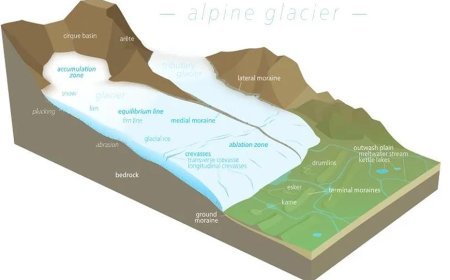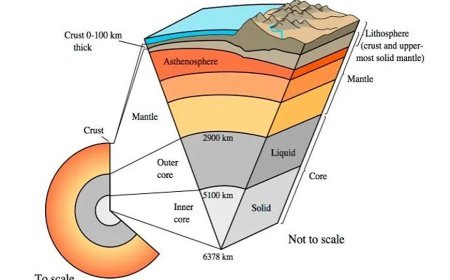CLEAVAGE AND TYPES OF CLEAVAGE
Rocks Split Apart: Cleavage Reveals Hidden Planes of Weakness (Types: Slaty, Fracture)

CLEAVAGE
- Cleavage is the tendency of a mineral to break along flat, planar surfaces dictated by the structure of its crystal lattice.
- The alignment of weaker atom connections in the crystal lattice creates cleavage planes, which are two-dimensional surfaces.
- The smoothness and presence of reflecting surfaces distinguish cleavage planes from fracture planes.
- Depending on the mineral, the number of cleavage planes varies. Mica has a single cleavage plane (for example, biotite, chlorite, or muscovite); feldspar has two that cross at 90° and amphibole (for example, hornblende) has two that do not intersect at 90°.
- Calcite contains three distinct cleavage planes that do not intersect at 90 degrees.
- Twinning can be seen in plagioclase and calcite specimens, as well as exceptionally fine examples of various other minerals. In contrast to cleft planes, which have no variation in reflectance, twin planes will seem to be alternately reflecting, dull, etc. Other minerals, such as pyrite and magnetite, may exhibit striations that resemble cleavage.
- In structural geology and petrology, cleavage is a type of planar rock structure that occurs as a result of deformation and metamorphism.
- The degree of deformation and metamorphism, as well as the rock type, dictate the type of cleavage feature that appears.
- Cleavage is a kind of rock foliation, which is a fabric element that specifies the production of planar structures in a rock.
- It frequently appears in fine-grained rocks made of minerals altered by pressure solutions.
- There are two forms of foliation: primary and secondary. Secondary rocks are metamorphic as a result of deformation and are igneous and sedimentary.
- Cleavage is a kind of secondary foliation that can be seen in fine-grained rocks.
- Schistosity refers to secondary foliation in coarser-grained rocks.
- Deformation and metamorphism are two processes that produce cleavage, a type of planar rock feature.
- The degree of deformation and metamorphism, as well as the rock type, dictate the type of cleavage feature that appears.
- These formations are frequent in fine-grained rocks made of minerals that have undergone pressure solution changes.
- Cleavage is a type of rock foliation that is defined by a fabric element that specifies the production of planar structures in a rock.
- There are two forms of foliation: primary and secondary.
- Secondary rocks are metamorphic as a result of deformation and are igneous and sedimentary.
- Cleavage is a kind of secondary foliation that may be seen in fine-grained rocks.
- Secondary foliation in coarser-grained rocks is referred to as schistosity.
- Certain rocks can divide into thin sheets along parallel lines that are closely spaced and may be inclined to bedding planes.
- This tendency of a rock is referred to as rock cleavage.
- When direct pressure forms foliated rocks, rock cleavage can be seen.
- It usually happens after some recrystallization and extension, with the minerals arranged in parallel.
- Rock cleavage is a distinguishing feature of metamorphic rocks like schists and slate.
- However, shales and limestone exhibit similar behavior when subjected to shear stresses at low temperatures.
- The parallel arrangement of the parts and the size differential of the constituent grains define the degree of cleavage.
- Cleavages occur in the plane of action of shear stresses, which may be oriented towards the direction of greatest pressure.
- Cleavage is a low-temperature variant of foliation that occurs best in rocks rich in platy minerals. Continuous or spaced cleavage can be distinguished.
Types of rock cleavage
Slaty Cleavage
- This is a kind of cleavage observed in slate and other micaceous-particle-rich rocks. Because of its smooth, flat surfaces, granite cracks easily in this condition.
- Slate is mostly made up of finely separated flaky minerals like mica and chlorite, as well as tabular minerals like feldspar and quartz.
- These minerals are flattened and elongated as a result of pressure during metamorphic processes.
- When shale is compressed, it folds at first, then the mineral grains extend and turn, resulting in slaty cleavage.
- The cleavage planes are perpendicular to the axial planes of the folds.
- The scale determines the nature of the fissure.
- Slaty cleavage is defined as a 0.5-mm or smaller space between layers.
- Slaty cleavage is the first cleavage characteristic to occur after deformation and is prevalent during diagenesis.
- The tectonic strain must be high enough to allow the creation of a new strong foliation, i.e., slaty cleavage.
Compaction Cleavage
- The history of compaction has had an impact on the earliest secondary foliation in sedimentary rocks.
- The original foliation (bedding) gets stronger and reworked when mineral grains move around and pores get smaller.
- A clay or claystone produces a shale with prominent compaction cleavage.
Continuous cleavage
- Continuous cleavage refers to fine-grained rocks having platy minerals that are evenly distributed in a preferred orientation.
- The minerals present determine the type of continuous cleavage that occurs. Minerals like quartz and calcite deform into a desired grain shape orientation, whereas undeformed platy minerals like micas and amphiboles align in a preferred orientation. Because continuous cleavage varies with size, a rock with continuous cleavage at the microscopic level may display signs of spaced cleavage at the macroscopic level.
Cleavage with gaps
- A small band of evenly spaced cleavage.
- Darker biotite grains with muscovite and quartz microlithons separating them are the cleavage domains.
- The microlithon grains are starting to line up in the desired orientation.
- Overprinting a new foliation on an old one revealed the beginnings of a crenulation cleavage.
- Spaced In rocks containing irregularly distributed minerals, cleavage occurs, resulting in the creation of discontinuous layers or lenses of diverse minerals.
- The two types of domains seen in cleavage are cleavage domains and microlithons.
- Planar borders that run parallel to the domain's trend are referred to as cleavage domains.
- The limits of microlithons are defined by the cleavage domains.
- If the grains inside spaced cleavage microlithons are randomly arranged or have microfolds from a previous foliation fabric, that can be used to describe them.
- Spaced cleavages are also known by other terms such as spacing size, cleavage domain shape and percentage, and the transition between cleavage domains and microlithons.
Crenulation cleavage
- In crenulation cleavage, microlithons bent by prior foliation can be detected.
- Folding occurs when deformation occurs in phases, the last of which forms symmetric or asymmetric microfolds that affect the foliations that come before.
- The lithology, as well as the degree of deformation and metamorphism, dictate the type of crenulation cleavage pattern generated.
Disjunctive cleavage
- Disjunctive cleavage is a type of spaced cleavage in which the microlithons are not deformed into microfolds and the formation is independent of the rock's previous foliation.
- Disjunctive cleavage is also known as fracture cleavage. This term should be avoided since it may mislead the formation of a cleavage feature.
What's Your Reaction?



































